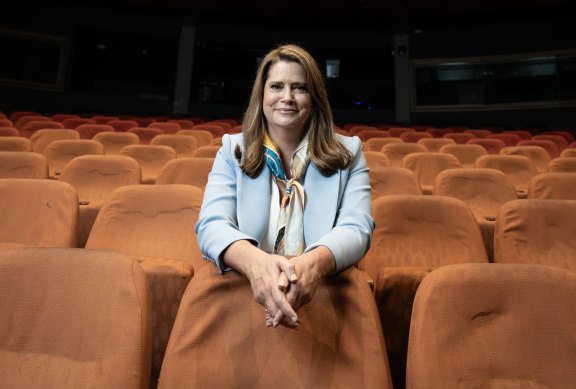
Whether any relief from external and internal pressures for Sneesby is momentary or more permanent probably depends on the findings of the external review the board has commissioned into the culture of its television business and whether Nine’s staff are satisfied with the company’s response to the events of the past few weeks.
Whatever the wash-up for Sneesby and Nine, for Costello, the end of his chairmanship, coinciding as it does with the end of his decade as chair of the Future Fund earlier this year, marks the conclusion of an era in the public spotlight.

Catherine West is taking on a difficult and demanding role at a pivotal moment for traditional media.Credit: Louie Douvis
The high watermark for Costello’s career was his period in parliament, where his 11 years as treasurer makes him Australia’s longest-serving treasurer. He presided over a lengthy string of budget surpluses and wiped out the federal government’s net debt during his tenure, which paved the way for the Future Fund. Had he been more ruthless and seized his opportunities, he could have been prime minister.
His Future Fund legacy is secure. It was Costello, as treasurer, who established the fund, which today has more than $220 billion of assets and is one of the more highly regarded sovereign wealth funds in the world.
His Nine legacy will be tarnished by the way it ended, but it wasn’t without its achievements, which he listed in the announcement of his resignation.
A little over a decade ago, when Costello joined the board, Nine was in the hands of distressed debt funds. It was recapitalised and was re-listed on the ASX in 2013.
Over the past decade, during most of which Costello was its chairman, Nine built a national free-to-air television network by buying stations in Adelaide and Brisbane. With Fairfax Media, it started the Stan subscription streaming business from scratch and, in 2018, it merged with Fairfax. That brought with it full ownership of Stan and a majority shareholding in the Domain property listings business.
The merger with Fairfax was an industry-changing deal and, by and large, has been successful even if some of the potential envisaged at its onset hasn’t been realised.
Nine hoped to introduce a studio partner as a shareholder in Stan; that hasn’t happened. There were thought to be more cross-platform opportunities than have been realised. Nine’s majority shareholding and media assets haven’t done much for Domain, whose market capitalisation is much the same as it was in 2018.
It has, however, been a difficult time for all traditional media. The big social media platforms and technology companies continue to gut traditional media of its advertising revenues and fragment their audiences. Free-to-air networks are battling the giant streaming services for audiences and revenues. The current economic environment isn’t helping.
Had he been more ruthless and seized his opportunities, he could have been prime minister.
Nine has fared better than most. It is the No.1 TV network. Its broadcast video-on-demand service is also the leader in its category. The Fairfax mastheads – The Sydney Morning Herald, The Age and The Australian Financial Review – are profitable and have built significant digital subscription bases. More than 60 per cent of the publishing division’s revenue flows from its digital offerings.
Boards set strategy so Costello, as the chair, can take significant credit for Nine’s successes during his tenure, albeit while also accepting responsibility for the opportunities that perhaps haven’t been realised.
On balance, given the industry’s difficult context, it has been a relatively positive period for Nine. It would have been a far weaker and more vulnerable entity if not for its expansion strategy over the past decade.
Nine’s new chair, Catherine West, will now have to deal with the outcomes from the culture review and grapple with the existential challenges confronting traditional media. As Costello said in his farewell statement, for traditional media, standing still isn’t an option.
Nor is cost-cutting by itself a strategy for success. Nine’s publishing business’ arch-rival, News Corp, is going through yet another brutal cost-reduction exercise as it tries to remake itself along similar lines to the structure Fairfax adopted more than a decade ago.
In the longer term, cost reductions buy time, not growth or security. Both Nine and News will need to devise more creative strategies. West is taking on a difficult and demanding role at a pivotal moment for traditional media.
Nine will miss Costello’s political instincts and connections because the industry’s future is bound up in its efforts to retrieve a share of the revenues it has lost to the tech giants. That inevitably involves government actions – the online platforms aren’t going to surrender the revenue they might generate from traditional media’s content.
Loading
The way Costello’s time in the public spotlight has ended is somewhat sad for someone who has been an important figure in Australia’s public life for decades. But then, as he would be well aware, almost all political lives – and the chair of Nine is a quasi-political role – tend to end in failure.
The Business Briefing newsletter delivers major stories, exclusive coverage and expert opinion. Sign up to get it every weekday morning.









 Add Category
Add Category